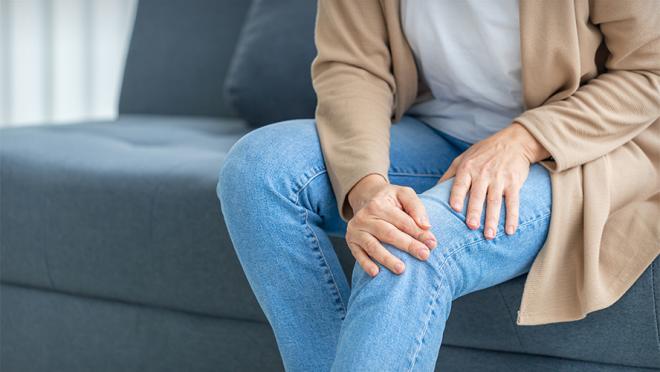
Researchers at the Schroeder Arthritis Institute have compiled a comprehensive overview of people living with knee and hip osteoarthritis (OA), aiming to create a valuable resource for global research and clinical progress.
OA, the most prevalent form of arthritis, arises as joint cartilage deteriorates. There is currently no cure or treatment that can slow disease progression. Available interventions include medications and, in severe cases, surgery to alleviate symptoms, such as pain and inflammation.
“The key with treating OA is intervening early, and helping patients manage their symptoms before they become debilitating,” says Dr. Michael Zywiel, a Clinician Investigator at the Schroeder Arthritis Institute and senior author of the study. “Although education and exercise are important parts of non-surgical care of knee and hip OA, access to structured and evidence-based care has been a challenge, negatively impacting patient care and outcomes.”
Addressing this gap, the University of Southern Denmark introduced the Good Life with osteoArthritis in Denmark (GLA:D®) program in 2013, a treatment program that combines exercise and education.
The GLA:D® program is targeted to people with mild to severe hip and/or knee OA and is a safe, cost-effective approach to improving pain, walking function and quality of life. Based on the program’s success in Denmark, it has been implemented by several other countries, including Austria, China, Switzerland and Canada.
With the help of researchers from the Schroeder Arthritis Institute, the GLA:D® Canada program was launched in 2017 by Bone and Joint Canada. GLA:D® Canada closely mirrors the Denmark program, including the development of a patient outcomes registry.
“Now that GLA:D® Canada has operated for over five years, we are in a good position to use this program and its outcomes to guide future OA research,” says Dr. Zywiel, who is also a Primary Investigator for the GLA:D® Canada Registry. “However, an important first step is to provide the OA research community with a comprehensive description of the participants who pursue education and exercise-based treatment of hip and knee OA in Canada.”
To analyze this data, Dr. Zywiel’s team summarized the sociodemographics (e.g., age and body mass index), clinical profiles (e.g., medical conditions and physical activity levels) and health status (e.g., pain intensity and joint function) of approximately 10,000 participants with hip and knee OA. The team collected this information through surveys that participants completed before starting and during the GLA:D® program.
“We identified several common characteristics of people who participate in the program, which will be useful for researchers when designing studies and recruiting patients,” says Dr. James Young, a Postdoctoral Researcher in Integrated Arthritis Care working with Dr. Zywiel, and the lead author of the study.
Their findings revealed that participants were predominantly female, averaging 66 years old and overweight or obese. Of these, two-thirds relied on pain medications and one-third considered joint surgery. Participants reported an average pain intensity of 5 out of 10 and activity levels averaged four days per week.
“Our results indicate that people who participate in the GLA:D® program in Canada are similar to those in Denmark and Australia,” explains Dr. Young, who is also on the leadership team for the GLA:D® International Network. “This similarity opens avenues for bridging international datasets and comparing data from multiple GLA:D® registries.”
These approaches will be important for studying program outcomes in a real-world setting, such as the effects of the program on health status, non-surgical outcomes and the need for joint replacement surgery, as well as barriers to therapy uptake.
“The Schroeder Arthritis Institute has been instrumental in implementing the GLA:D® program in Canada and we are excited for the potential to use the GLA:D® registry to tackle big questions in the field,” concludes Dr. Zywiel.
This work was supported by UHN Foundation. Dr. Michael Zywiel is an Assistant Professor of Surgery at the University of Toronto.
Dr. Michael Zywiel has been a paid consultant to Smith and Nephew, DePuy Synthes, Johnson & Johnson, ZimmerBiomet and OPEXC Inc. Co-author Dr. Christian Veilette has served as a paid consultant, board member or received research support from Zimmer Biomet, CODMAN Group, DePuy Synthes, Orthogate, Orthopaedic Web Links, OrthopaedicsOne, and Smith and Nephew. Co-author Dr. Rhona McGlasson is the National Director of GLA:D® Canada and Executive Director of Bone and Joint Canada.
Young JJ, Perruccio AV, Veillette CJH, McGlasson RA, Zywiel MG. The GLA:D® Canada program for knee and hip osteoarthritis: A comprehensive profile of program participants from 2017 to 2022. PLoS One. 2023 Aug 3. doi: 10.1371/journal.pone.0289645.

Common symptoms of knee and hip OA include pain while walking, joint stiffness and reduced flexibility.




